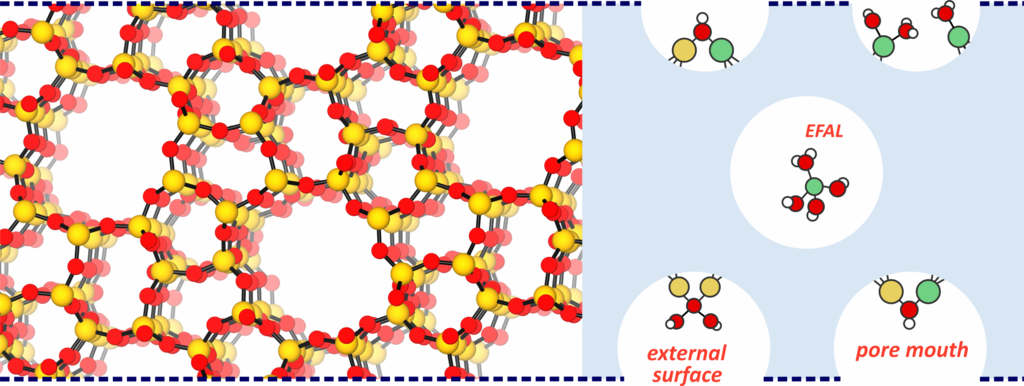Exploring the role of external zeolite surfaces and EFAl species in catalytic alkene cracking
Exploring the role of external zeolite surfaces and EFAl species in catalytic alkene cracking
Promotor(en): V. Van Speybroeck /25567 / Nanoporous materialsBackground and problem
Zeolite catalyzed alkene cracking plays a crucial role in both classical petrochemical processes, like FCC, as well as emerging alternatives for the on-purpose production processes of light olefins, fuels and aromatics, such as the methanol-to-olefins (MTO) process, CO2 hydrogenation or biomass conversion. Alkene cracking occurs through a complex reaction network of hydride transfer, isomerization, oligomerization and β-scission reactions in which carbenium ion intermediates are known to play an active role. [1] Due to the high reactivity of these intermediates, detailed information on individual reaction steps can hardly be obtained from experiments. Instead, ab initio simulations can assist in unraveling the reaction mechanism at the molecular level.
Today, many modeling studies represent zeolites as ideal materials containing isolated Brønsted acid sites in the bulk zeolite. In reality, however, zeolites are more complex containing both a confined microporous network and external surfaces. [2-4] The presence of acid sites at the external surface can result in the observation of pore-mouth catalysis, which is important for bulkier hydrocarbons in particular as these species are prohibited from diffusing inside the micropores. [2] Furthermore, post-synthesis treatments of the catalyst are known to introduce Lewis acidic extra-framework aluminum (EFAl) species in the zeolite pores which are beneficial for the thermal stability and the catalytic activity. [3,4] The zeolite will therefore contain a combination of active sites with Lewis acidic and Brønsted acidic properties, each of which may have a distinct influence on the stability of the intermediates and on the preferred cracking pathways. In contrast to the typical Bronsted acid sites, the precise nature of the EFAl species and their specific role on the catalytic cracking mechanism is poorly understood. Nevertheless, such insight is required to improve the catalyst stability and selectivity of catalytic cracking units.

Figure 1. Schematic representation of a ZSM-5 catalyst with indication of EFAl species at the external surface and at the pore-mouth.
Goal
The goal of this master thesis is to study how active site engineering by metal incorporation in the zeolite will influence the stability and reactivity of alkene cracking intermediates. First, you will construct advanced zeolite models to represent the external zeolite surface and investigate the nature of the EFAl species at the external surface. After a detailed characterization of the active sites, the second phase will consist of assessing the stability of a broad range of cracking intermediates at the external surface sites. Thirdly, you will compare the effect of these EFAl Lewis acid sites on the reaction rate of some key elementary steps (hydride transfer, oligomerization, β-scission …) at the external surface and inside the micropores. To achieve this goal, you will perform a state-of-the-art molecular dynamics study which allows to mimic realistic process conditions. Ultimately, the outcome of these simulations will result in a thorough analysis of active sites inside the micropores or at the external surface and assist in evolving towards a more realistic model representation of the complex zeolite environment.
This project requires the application of several advanced molecular simulation techniques, which rely on first principle static and molecular dynamics simulations. The Center for Molecular Modeling has built up vast expertise in these simulation techniques and collaborates on the subject with leading experimental partners. The student will be actively coached to get acquainted with the simulation techniques needed to tackle the proposed problem. The necessary computational resources to execute this research project will be provided by the CMM. The proposed topic is challenging and requires technical skills, creativity and chemical insight.
- Study programmeMaster of Science in Chemical Engineering [EMCHEM]KeywordsHeterogeneous Catalysis, Zeolites, Catalytic Cracking, CarbocationsReferences
[1] P. Cnudde et al., ACS Catal. 8 (2018) 9579-9595.
[2] C. Chizallet et al., ACS Catal. 10 (2020) 5579-5601.
[3] M. Ravi et al., Nat. Mater. 19 (2020) 1047-1056.
[4] X. Yi et al., JACS 140 (2018) 10764-10774.
